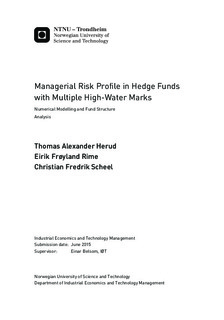Managerial Risk Profile in Hedge Funds with Multiple High-Water Marks - Numerical Modelling and Fund Structure Analysis
Master thesis
Permanent lenke
http://hdl.handle.net/11250/2352907Utgivelsesdato
2015Metadata
Vis full innførselSamlinger
Sammendrag
We investigate a hedge fund manager's risk-taking profile and evaluate how fund composition and multiple evaluation periods affect risk-levels. The fund composition refers to the specific characteristics that result from investors entering the fund at different points in time, implying various maturities and strike levels for high-water mark incentive contracts. Multiple evaluation periods is the inclusion of long-term managerial compensation to the decision process. Using a numerical simulation framework we compute and analyse the optimal behaviour of a fund manager with constant relative risk aversion. In existing literature - where the fund is depicted as one, homogeneous pool of investments, evaluated over a single period - manager risk-taking fluctuates heavily depending on time to maturity and moneyness of the manager's incentive option. By introducing a diversified fund composition as well as accounting for multiple evaluation periods, the manager's behaviour is considerably less extreme, reducing manager-investor risk misalignment. Our results suggests that the fund composition is relevant to the individual investor, as it potentially affects the overall risk profile and thereby the value of the investment. Furthermore, our results prove an interesting study in examining the efficiency of option-like incentive contracts in relieving agency problems.
